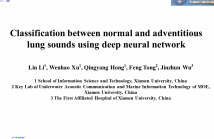- Read more about Greedy Deep Transform Learning
- Log in to post comments
We introduce deep transform learning – a new
tool for deep learning. Deeper representation is learnt by
stacking one transform after another. The learning proceeds in
a greedy way. The first layer learns the transform and features
from the input training samples. Subsequent layers use the
features (after activation) from the previous layers as training
input. Experiments have been carried out with other deep
representation learning tools – deep dictionary learning,
stacked denoising autoencoder, deep belief network and PCANet
- Categories:
 73 Views
73 Views- Read more about Biobotic Motion and Behavior Analysis in Response to Directional Neurostimulation
- Log in to post comments
This paper presents preliminary results for motion behavior analysis of Madagascar hissing cockroach biobots subject to stochastic and periodic neurostimulation pulses corresponding to randomly applied right and left turn, and move forward commands. We present our experimental setup and propose an unguided search strategy based stimulation profile designed for exploration of unknown environments. We study a probabilistic motion model fitted to the trajectories of biobots, perturbed from their natural motion by the stimulation pulses.
Poster.pdf
- Categories:
 28 Views
28 Views- Read more about mbedded Clustering via Robust Orthogonal Least Square Discriminant Analysis
- Log in to post comments
- Categories:
 5 Views
5 Views- Read more about A SEMI-SUPERVISED METHOD FOR MULTI-SUBJECT FMRI FUNCTIONAL ALIGNMENT
- Log in to post comments
Practical limitations on the duration of individual fMRI scans have led neuroscientist to consider the aggregation of data from multiple subjects. Differences in anatomical structures and functional topographies of brains require aligning data across subjects. Existing functional alignment methods serve as a preprocessing step that allows subsequent statistical methods to learn from the aggregated multi-subject data. Despite their success, current alignment methods do not leverage the labeled data used in the subsequent methods.
- Categories:
 8 Views
8 Views- Read more about Semi-Supervised Classification via Both Label and Side Information
- Log in to post comments
poster_1.pdf
- Categories:
 23 Views
23 Views- Read more about HEARTMATE: AUTOMATED INTEGRATED ANOMALY ANALYSIS FOR EFFECTIVE REMOTE CARDIAC HEALTH MANAGEMENT
- Log in to post comments
Remote cardiac health management is an important healthcare application. We have developed Heartmate that enables basic screening of cardiac health using low cost sensors or smartphone-inbuilt sensors without manual intervention. It consists of robust denoising algorithm along with effective anomaly analytics for physiological signals. Heartmate identifies and eliminates signal corruption as well as detects cardiac anomaly condition from physiological cardiac signals like heart sound or phonocardiogram (PCG) and photoplethysmogram (PPG).
- Categories:
 21 Views
21 Views
In this paper, we mine the US congress voting records to extract the latent information about the trust among congress members. In particular, we model the Senate as a social network and the voting process as a set of outcomes of the underlying opinion dynamics which we assume follow a corrupted DeGroot model. The transition matrix in the opinion dynamics model is the trust matrix among Senators that we estimate.
- Categories:
 10 Views
10 Views
- Read more about Coupled Dictionary Learning for Multi-modal Image Super-resolution
- Log in to post comments
- Categories:
 3 Views
3 Views
- Read more about Classification between normal and adventitious lung sounds using deep neural network
- Log in to post comments
- Categories:
 17 Views
17 Views- Read more about Mood State Prediction from Speech of Varying Acoustic Quality for Individuals with Bipolar Disorder
- Log in to post comments
Speech contains patterns that can be altered by the mood of an individual. There is an increasing focus on automated and distributed methods to collect and monitor speech from large groups of patients suffering from mental health disorders. However, as the scope of these collections increases, the variability in the data also increases. This variability is due in part to the range in the quality of the devices, which in turn affects the quality of the recorded data, negatively impacting the accuracy of automatic assessment.
- Categories:
 13 Views
13 Views